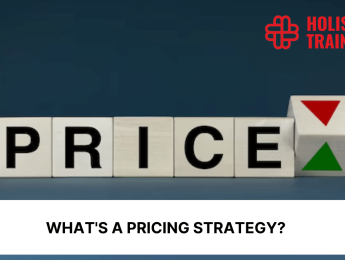- Table of Contents
- What's a Pricing Strategy?
- Why Is Having a Pricing Strategy Important?
- 1. Profit Maximisation
- 2. Perceived Value
- 3. Competitive Edge
- 4. Market Positioning
- 5. Demand Management
- What Does a Weak Pricing Strategy Lead to?
- 1. Profit Erosion
- 2. Customer Perception
- 3. Loss of Market Share
- 4. Undercutting Profit Margins
- 5. Negative Perceptions
- 8 Popular Pricing Strategies and Examples
- 1. Cost-Plus Pricing
- 2. Value-Based Pricing
- 3. Competitive Pricing
- 4. Penetration Pricing
- 5. Skimming Pricing
- 6. Bundle Pricing
- 7. Psychological Pricing
- 8. Dynamic Pricing
- How to Create a Pricing Strategy
- Understand Costs
- Analyse Market
- Determine Value
- Choose a Strategy
- Test and Refine
- Consider Elasticity
- Factor in Discounts and Promotions
- Stay Agile
- How to Know Which Strategy Is the Right One for You
- Product Type:
- Market Positioning:
- Competitor Landscape:
- Target Audience:
- Business Goals:
- Conclusion
Introduction: What's a Pricing Strategy?
Crafting a masterpiece involves more than just applying brushstrokes to a canvas; it demands a keen understanding of colours, composition, and the emotions they evoke. Similarly, pricing your products transcends mere numbers – it's a symphony of strategy, psychology, and perception that can make or break your business's success. In this exploration of pricing strategies, we'll venture into the intricate world of strategic pricing. We'll delve deep into why a well-thought-out pricing strategy is essential, the consequences of overlooking this critical aspect, popular pricing strategies embellished with real-world examples, the process of creating a strategy tailored to your business, and the art of choosing the strategy that resonates with your brand's essence. Let's embark on this journey to uncover the secrets of pricing that go beyond digits and decimals.
A pricing strategy is a well-thought-out approach to determining the optimal price for your products or services. It's more than just attaching a random number to your offerings; it involves a careful consideration of various factors such as production costs, market demand, competitor pricing, perceived value, and the goals of your business.
Why Is Having a Pricing Strategy Important?
In the vast sea of business decisions, pricing stands as a lighthouse, guiding your ship towards profitable shores. It's not just a matter of slapping a price tag on your products and hoping for the best; it's a calculated and strategic move that can make or break your business. Let's delve deeper into why having a pricing strategy is of paramount importance:
1. Profit Maximisation
At the heart of every business lies the pursuit of profit. A well-crafted pricing strategy acts as a compass, steering you toward the optimal pricing point that balances revenue with expenses. If prices are set too high, customers might shy away, causing sales to plummet. Conversely, pricing too low might attract customers but fail to cover production costs, leading to a situation where higher sales volume doesn't translate into sustainable profits. A pricing strategy, carefully designed based on accurate cost analysis and market demand, helps you find that sweet spot where profits flourish. In fact, according toPaddle, pricing is four times more effective in enhancing revenue compared to acquisition, and it is twice as potent as a means of improving retention.
2. Perceived Value
Have you ever walked into a store and wondered why one product costs significantly more than another, seemingly similar product? The answer lies in the concept of perceived value. Pricing isn't just about numbers; it's about influencing how customers perceive the value of your offerings. A strategic pricing approach can make your products appear more premium, luxurious, and desirable. By setting a price that reflects the quality, uniqueness, and benefits your products offer, you can attract customers who are willing to pay for that added value.
3. Competitive Edge
In the bustling marketplace, standing out from the competition is essential. Pricing can be a powerful tool for differentiation. A thoughtfully designed pricing strategy allows you to position your products distinctively within the market landscape. You can choose to be a high-end brand, offering unparalleled quality and charging a premium for it. On the other hand, you might opt for a budget-friendly approach that targets price-sensitive customers. Your pricing strategy is your canvas, and you get to paint the image of your brand's identity with every price point you choose.
4. Market Positioning
Imagine you're shopping for a new smartphone. You come across two options: one priced significantly higher than the other. Your first thought might be that the more expensive one is better. This is the power of market positioning through pricing. Your pricing strategy can help you create an image of exclusivity, accessibility, or something in between. Your target audience's perception of your product's worth can heavily influence their buying decision. A strategic pricing approach ensures that your products are positioned where you want them to be in your customers' minds.
5. Demand Management
The ebb and flow of demand is a challenge that every business faces. Pricing strategies can be used to manage these fluctuations effectively. During peak seasons, you might adjust prices slightly higher to capitalise on increased demand. Conversely, during off-peak periods, you could implement promotional pricing to stimulate sales. A well-planned strategy enables you to navigate these demand variations while maintaining a stable flow of revenue.
What Does a Weak Pricing Strategy Lead to?
In the intricate dance of business decisions, few missteps can have as far-reaching consequences as a weak or poorly executed pricing strategy, and many have fallen into this rabbit hole. In fact,McKinsey & Company has estimated that as much as 30 percent of the numerous pricing decisions made by companies each year do not result in the optimal price. Just as a leak can sink a ship, a flawed pricing strategy can lead your business down a perilous path. That being said, let's delve deeper into the repercussions of a weak pricing strategy:
1. Profit Erosion
One of the most immediate and tangible effects of a weak pricing strategy is profit erosion. Without a clear and calculated approach to pricing, you risk setting prices that fail to cover your production costs, operational expenses, and marketing efforts. This results in razor-thin profit margins, or worse, operating at a loss. In such scenarios, even if your product gains traction in the market, the lack of profitability can cripple your ability to invest in growth, innovation, and sustaining your business in the long run.
2. Customer Perception
Imagine entering a high-end store and finding a designer bag priced suspiciously low. Your initial reaction might be scepticism about the bag's authenticity or quality. Similarly, a weak pricing strategy can send confusing signals to your potential customers. If your product is priced significantly lower than its perceived value, customers might question its quality, authenticity, or overall worth. On the flip side, overpricing can deter price-sensitive customers, leading to missed opportunities for sales.
3. Loss of Market Share
A weak pricing strategy can open the door for your competitors to swoop in and steal your market share. If your pricing isn't competitive, customers might turn to alternatives that offer similar value at a more attractive price point. Losing market share not only impacts your immediate sales but also weakens your position in the market. It becomes increasingly challenging to regain lost ground and regain customer trust once competitors have seized the opportunity.
4. Undercutting Profit Margins
Setting prices arbitrarily without considering your costs can have the unintended consequence of undercutting your profit margins. Even if you manage to attract customers with lower prices, the lack of profitability can render those sales ineffective in sustaining your business. A steady stream of sales with insufficient profit margins can lead to a scenario where you're working tirelessly to meet demand but still struggling to keep your operations afloat.
5. Negative Perceptions
A weak pricing strategy can create negative perceptions about your brand. Customers might view your products as cheap or inferior if they're priced lower than similar offerings in the market. On the other hand, if your products are consistently overpriced, you might develop a reputation for being out of touch with your customers' needs and financial realities. Negative perceptions can erode customer loyalty and make it challenging to build a strong and lasting brand image.
8 Popular Pricing Strategies and Examples
In the realm of business, pricing strategies are akin to a palette of colours that artists use to create masterpieces. Each strategy has its own nuances and influences, giving you the power to craft a pricing approach that aligns with your goals and resonates with your target audience. Let's delve into eight popular pricing strategies, accompanied by real-world examples that illustrate their application:
1. Cost-Plus Pricing
Cost-plus pricing is a straightforward approach where you calculate the production costs of your product and then add a predetermined profit margin. This method ensures that your product's price covers all expenses while generating a profit. For instance, a local bakery calculates the cost of ingredients, labour, and overhead for a batch of cookies and then adds a 40% markup to determine the selling price.
2. Value-Based Pricing
Value-based pricing hinges on the perceived value your product offers to customers. This strategy requires a deep understanding of your target audience's preferences and willingness to pay for unique features or benefits. A luxury watch manufacturer leverages value-based pricing by setting higher prices for timepieces that boast intricate craftsmanship and exclusive designs, reflecting the perceived worth of these items.
3. Competitive Pricing
Competitive pricing involves setting prices in line with or slightly below your competitors' prices. This approach is particularly useful in saturated markets where customers often compare prices before making a purchase decision. A new smartphone brand enters the market and strategically prices its flagship model slightly lower than the leading competitors to attract attention and gain a foothold.
4. Penetration Pricing
Penetration pricing entails setting an initial low price for your product to capture a significant market share quickly. This strategy aims to attract price-sensitive customers and create a buzz around your offerings. A newly launched ride-sharing app adopts penetration pricing by offering significantly discounted fares for the first month, attracting a surge of users and establishing a user base.
5. Skimming Pricing
Skimming pricing involves setting a high initial price for a product and gradually lowering it as demand tapers off. This strategy is often used for cutting-edge products that cater to early adopters willing to pay a premium. An electronics company introduces a state-of-the-art VR headset at a premium price, and as the technology becomes more mainstream, they lower the price to reach a broader audience.
6. Bundle Pricing
Bundle pricing bundles multiple products or services together and offers them at a lower combined price compared to purchasing each item individually. This encourages customers to buy more items at once and can increase the perceived value of the offer. A software company packages its various productivity tools into a single bundle at a price significantly lower than the sum of individual tool prices, attracting customers looking for a comprehensive solution.
7. Psychological Pricing
Psychological pricing relies on human psychology to influence buying decisions. Prices are set just below whole numbers (e.g., $9.99 instead of $10.00) to create the illusion of a lower price. This strategy capitalises on customers' tendency to focus on the leftmost digits of a price. For example, a retail clothing store prices a trendy t-shirt at $19.99 instead of a rounded $20, aiming to make the item appear more affordable. And this actually works. In fact, according to research conducted at UC Berkeley in 2018, as mentioned in an article by Inc., people tend to perceive prices ending in .99 as being 15 to 20 cents lower on average. Weird, right?
8. Dynamic Pricing
Dynamic pricing involves adjusting prices in real-time based on factors such as demand, time of day, or customer demographics. This strategy is common in industries like travel, hospitality, and e-commerce. An airline alters ticket prices based on factors like the season, time until departure, and current demand, ensuring that prices remain competitive while maximising revenue.
In essence, pricing strategies are like musical notes that, when combined skillfully, create a symphony that resonates with your customers. Your choice of strategy depends on your product type, market position, competition, and business goals. By embracing these strategies and adapting them to your unique circumstances, you gain the ability to wield pricing as a tool to not only drive sales but also shape the perception of your brand in the minds of consumers.
Table 1: Comparing pricing strategies
Pricing Strategy | Description | Example |
Cost-Plus Pricing | Calculating production costs and adding a profit margin for pricing. | Local bakery pricing cookies with a 40% markup. |
Value-Based Pricing | Pricing based on the perceived value of the product to the customer. | Luxury watch manufacturer setting prices for exclusivity. |
Competitive Pricing | Setting prices in line with or slightly below competitors' prices. | New smartphone brand pricing slightly lower than rivals. |
Penetration Pricing | Initial low price to capture a significant market share quickly. | Ride-sharing app offering discounted fares on launch. |
Psychological Pricing | Pricing just below whole numbers to create the illusion of a lower price. | Retail store pricing a trendy t-shirt at $19.99. |
How to Create a Pricing Strategy
Crafting an effective pricing strategy is akin to assembling the pieces of a complex puzzle. It requires a thorough understanding of your business, your market, and your customers. Let's break down the process step by step to help you create a pricing strategy that's not just a number, but a well-informed decision:
Understand Costs
Begin by meticulously dissecting your costs. Calculate every aspect involved in producing, marketing, and delivering your product. This includes raw materials, labour, manufacturing, packaging, shipping, marketing expenses, and overhead costs. A comprehensive grasp of your costs forms the foundation upon which your pricing strategy is built.
Analyse Market
Dive into market research to comprehend your competitors' pricing, customer preferences, and market trends. Understand how your product fits into the larger market landscape. Identify what sets you apart and where you can provide added value. By benchmarking against competitors and gauging the pulse of the market, you gain insights that inform your pricing strategy.
Determine Value
Evaluate the unique value proposition your product offers to customers. Consider both tangible features and intangible benefits. How does your product solve a problem or enhance their lives? This intrinsic value should be reflected in your pricing. A luxury car manufacturer, for instance, prices its vehicles higher due to the advanced technology, superior performance, and prestigious branding it offers.
Choose a Strategy
Selecting a pricing strategy is where the art of pricing comes into play. Based on your analysis of costs, market, and value, decide which strategy aligns with your goals and resonates with your target audience. If you're introducing a new product in a competitive market, penetration pricing might be a wise choice. Alternatively, if your product offers unique features, value-based pricing could be more suitable.
Test and Refine
Implementation is just the beginning. Once your pricing strategy is in place, continuously monitor its performance and gather feedback. Are customers responding as expected? Are you meeting your revenue targets? Be open to making adjustments based on real-world outcomes. If a certain pricing point isn't resonating with customers, consider tweaking it to align better with their perceptions.
Consider Elasticity
Price elasticity measures how responsive demand is to price changes. Some products are highly elastic, meaning a small price change can result in a significant change in demand, while others are inelastic, where price changes have less impact on demand. Understanding the elasticity of your product can guide you in setting prices that maximise revenue without negatively affecting demand.
Factor in Discounts and Promotions
Incorporate planned discounts and promotions into your pricing strategy. These can create a sense of urgency, attract new customers, and stimulate sales during slow periods. However, ensure that even with these discounts, your profit margins remain intact. A well-timed promotion can be a powerful tool, but it should align with your long-term goals.
Stay Agile
The business landscape is ever-evolving, and your pricing strategy should be flexible enough to adapt. Market trends, changes in customer preferences, and economic fluctuations can all influence your pricing decisions. Regularly review and adjust your strategy to remain competitive and relevant.
In short, creating a pricing strategy is a multidimensional endeavour that fuses data analysis, customer psychology, and strategic thinking. It requires a delicate balance between covering costs, providing value, and staying competitive. By meticulously assessing costs, conducting thorough market research, understanding your product's value, and selecting an appropriate strategy, you lay the groundwork for a pricing approach that not only drives sales but also positions your brand for long-term success. Remember, a pricing strategy isn't set in stone; it's a dynamic tool that you can refine and optimise as your business evolves in the ever-changing market landscape.
How to Know Which Strategy Is the Right One for You
Choosing the right pricing strategy is a nuanced decision that depends on various factors:
Product Type:
The choice of pricing strategy should align with the characteristics of your product. If you're offering a luxury item, a higher price point may be justified to maintain exclusivity and perceived value. On the other hand, if your product is a commodity, a competitive pricing strategy might be necessary to capture a larger market share.
Market Positioning:
Your pricing strategy plays a crucial role in shaping how consumers perceive your brand. Opting for premium pricing can establish an image of quality and exclusivity, while budget-friendly pricing may attract cost-conscious shoppers. Striking a balance between the two can position your brand as offering a reasonable value for the quality provided.
Competitor Landscape:
A thorough analysis of your competitors' pricing strategies can provide valuable insights. If they're pricing their products higher, it might create an opportunity for you to position yourself as a more affordable alternative. Conversely, if they are undercutting prices, you might need to evaluate the feasibility of maintaining higher prices while offering unique value propositions.
Target Audience:
Understanding your target audience is essential in determining the right pricing strategy. Different demographics may have varying levels of price sensitivity. Conduct market research to gauge their willingness to pay and tailor your pricing accordingly. Consider factors such as income, age, and geographical location in this assessment.
Table 2: Factors influencing pricing strategies
Business Goals:
Your pricing strategy should align with your overarching business objectives. If your primary goal is to maximise profits, you may opt for premium pricing with added features or services. If you aim to gain a larger market share, competitive pricing might be more suitable. When looking to penetrate a new market, a flexible pricing approach that considers local economic conditions may be necessary to establish a foothold. Your pricing strategy should be a strategic tool that supports your broader business goals and growth plans.
Conclusion
Pricing strategies are an essential tool in the modern business arsenal. They go beyond mere number crunching, offering a sophisticated way to influence customer behaviour, manage profits, and establish a strong market presence. By understanding the nuances of different strategies, conducting thorough research, and aligning your approach with your brand and objectives, you can confidently set prices that not only drive sales but also contribute to the long-term success of your business. Remember, pricing is an art, and with the right strategy, you can paint a masterpiece that captures both the hearts of customers and the heights of profitability.
As you embark on your journey to becoming a pricing virtuoso, remember that continuous learning is the key to staying ahead. If you're ready to delve even deeper into the world of pricing strategies and unlock the secrets of driving revenue, make sure to check out our course: ‘Pricing Strategies Based on Revenue.’ This course will equip you with the tools and insights needed to navigate the intricate landscape of pricing, empowering you to craft strategies that not only boost sales but also elevate your business to new heights.






















